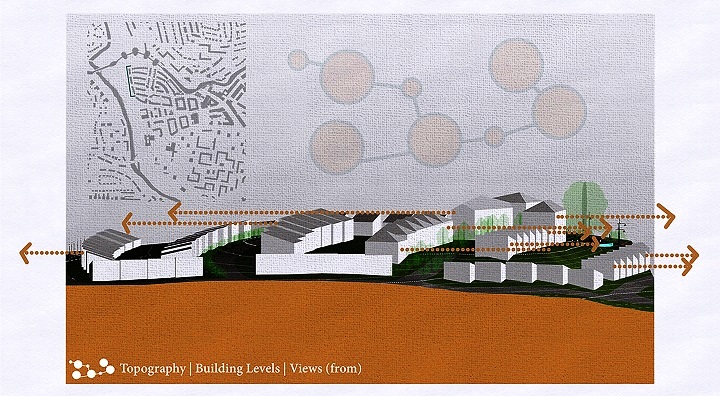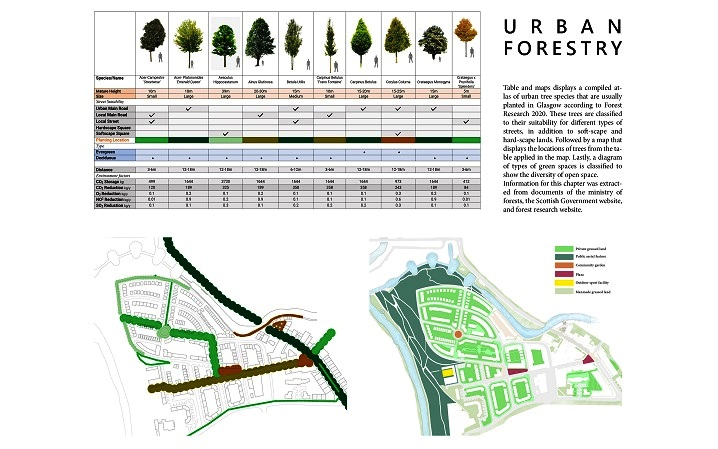It is indeed fascinating to meet and interact with creative individuals from all across the globe. Each individual that I interact and meet teaches me so much to enhance my appetite for knowledge. Knowledge not only shapes individuals, but also empowers nations in real sense. It is prodigious to see the rise of African nations in the field of architecture in the recent decades. I am very-very impressed to meet amazingly creative individuals from various African nations. Their design creations are not only futuristic, but also very sustainable in nature.
From Oxford Brookes University, the GEN Z Series travels to the University of Strathclyde, Glasgow in Scotland to meet a 2020 graduated Master’s in Advanced Architectural Design with distinction architect Nadine Tarig from Sudan. Post Masters, she joined ALSADD Consulting Engineering, Doha in Qatar as an Assistant Architect. Nadine Tarig’s has an astounding family lineage. She reveals, “I was born in Sudan into a multiracial family. My father is Bulgarian-Sudanese, while my mother is Japanese-Sudanese. My native language is Arabic and I am fluent in English. I also speak Bulgarian and Japanese (smiles). Growing up with such exposure to diversity, I developed an early sense of empathy in understanding cultural variations which later has influenced my work.”

Landmark Site Plan
Nadine Tarig’s strong families’ background with academic roots in the medical, engineering and architecture has indeed influenced her upbringing. She enthuses, “We grew up in an extended family of academics, primarily doctors and engineers. My father, a Chief Architect inspired my passion for architecture. After High School, I left Sudan in 2012 to pursue my Part 1 studies at Limkokwing University of Creative Technology in Malaysia, before gaining practical experience during a placement year in Qatar. My journey continued in Scotland at the University of Strathclyde.” Nadine is the eldest among her four siblings. Her younger brother is majoring in Journalism and Mass Communications at the American University in Bulgaria, while the two younger ones are in High School now.
Johnny D interacts with Nadine Tarig to explore her interesting journey to follow on her father’s footsteps and her thesis ‘Touring the Contour, Glasgow’.

10-year Action Plan
What was your childhood ambition? Did you always wanted to become an architect?
Most of my childhood ambitions revolved around a central theme of artistic expression. At times, I wanted to be a musician and even used to imagine myself to be a poet or a painter (smiles). However, I was always fascinated watching my father working late night on CAD drawings on the screen. As an eight-year girl, I was curious by the lines and compositions on his blueprints. I used to look at floor plans and was sure that I wanted to be able to create similar drawings, when I grew up. Watching his passion and drive in practicing architecture consolidated the appeal of his ‘cool adult job’ even more so (smiles).

Detailed Master Plan
How has architecture influenced your life as a student?
I think architecture school has shaped and rewritten my entire thought process in a sense. I gained research and critical thinking skills that expanded to all aspects of my life. I also acquired a keen interest in trans-disciplinary studies involving History, Psychology, Philosophy and the built environment, which consequently shaped my habits and the media I consume.
Briefly tell us about your University and the Masters’ Course.
Relocating to a new colder environment and balancing coursework with a part-time job in the U.K was initially challenging. I made the decision to defer my studies for a year to better prepare for success, ultimately graduating in 2020 with honors. My family provided unwavering support throughout this challenge.

Building Model
While I was initially interested in building design, the 2019 revolution in Sudan reshaped my academic interests, steering me towards urban design and master planning, particularly at the neighborhood level. My focus shifted from flashy self-expression to community purpose-driven design emphasizing inclusivity, affordability, participatory design and civil stewardship.
What role do you perform as an Assistant Architect at ALSADD Consulting Engineering?
While working towards attaining my architecture license, at ALSADD, I learned from and work alongside my mentor, and as part of a team. Given that my core architectural philosophy is human-centric (in creating contextual, meaningful, efficient and accessible spaces), since graduating, my most significant real-life project involved proposing an exhaustive manifesto of modular spaces around water wells; powered by solar energy to address water inaccessibility and contamination issues in the poverty stricken areas of rural Sudan.

Schedule of Accommodation
Briefly describe the significance of your project with the ‘Title of the Project’.
Buildings are a part of cities and I believe good architecture starts at the big picture. My Master’s project ‘Touring the Contour’ is a plot-based urban regeneration project at the neighborhood scale; a ‘place-making’ vision for a 10-year roadmap that holistically revitalizes an area into a potentially lively, aesthetically pleasing, meaningful place.
The chosen site is a large district in the North-West of Glasgow in Scotland called ‘Maryhill’. With some areas in the north of Glasgow that prioritize vehicles, suffer from dead high-streets, poor living conditions, uneven urban development and derelict spaces – parts of Maryhill were no different.

Concept and Temporal Maps
In attempts to blend with the existing site, the project aimed to address these issues from the grassroots up. The goal was to promote a lifestyle, refresh the high street, reawaken and link dormant spaces. Thus, The existing street network was redesigned and incorporated a connected series of strategically placed public open spaces in the vicinity of historical landmarks that take pedestrians through a ‘heritage walking experience’ in Maryhill.
Additionally, the project introduced over 800 home units accommodating various population densities of which 37% are various house dwellings and 63% are apartment flats, as well as a local market and a community center. Moreover, urban forestry studies and tree species considerations were also fused into the project.
In theory, if the risk of gentrification is sensibly assessed, the project has the potential to enhance the quality of life in terms of walkability, job creation, proximity to facilities, housing affordability and an increased sense of ‘place identity’ and belonging.

Building in Context
Which National or International architect(s) has inspired / influenced you? Please specify as to why?
A great number of architects, scholars and works have inspired me throughout my growing up years. However, I find myself more influenced by ‘schools of thought’ that aligns with my values and vision. For example, I tend to navigate towards scholars that challenge the Eurocentric ideals of global urbanization and shed light on context-responsive design like Abdoumaliq Simone, Gautam Bhan, Ananya Roy and Nabeel Hamdi. I also admire experts that foster ‘place identity’ through design and advocate for pedestrian-friendly cities like Kevin Lynch, W.H. Whyte, Jan Gehl and Jane Jacobs.

Storefront Modular Unit Model
As an Intern, what is the most important lesson(s) you have learnt from senior architects, while being a part of a project?
A crucial recurring theme has been the importance of minimizing personal ego in favor of promoting teamwork and collaboration. The emphasis on collective achievement over individual recognition creates a culture of humility and empathy, ensuring that projects are approached with a genuine understanding and a unified vision.

Landmark Buildings
However, the three notable lessons / skills that I learned during my internships are:
(i). Importance of creating efficient organization and tagging systems for my files and drawings;
(ii). Soft skills like conducting self with clients in a warm, but professional manner or how to respond, when I do not know the answer; and
(iii). Flexibility and compromise – in the sense of not being married to a specific idea in design and working within the project’s practical limitations and stakeholder’s preferences.

Shadow Studies
Will the younger generation of architects make innovative changes to mitigate the catastrophic effects of Climate Crisis? Elucidate your perspectives.
Yes, I believe so, with more collective initiatives that spread awareness and take action. For example, I greatly admire the AAS – Anthropocene Architecture School – an education and ‘unlearning’ platform that advocates for climate literacy and spatial justice – encouraging designers to consider the building’s environmental impact, while making the earliest design decisions to minimize the ecological and health impacts later on.

Site Topography
Which significant aspects of the global platform ‘zerobeyond – the new frontier!’ did you liked the most, and why?
A striking aspect that resonated with me is the commitment to showcasing the creative potential of young architects. This not only creates a global exposure for emerging voices, but also fosters a sense of community. I also deeply appreciate the platform’s proactive approach in recognizing the impending challenges faced by our generation – it indicates a forward-thinking mindset. The underlying notion of ‘giving back to society’ speaks volumes about the platform’s values.

Primary Space
‘zerobeyond – the new frontier!’ stands out to me by emphasizing collective growth and societal betterment. This holistic approach combining mentorship, global exposure and societal contribution is both commendable and inspiring. That in addition to how the platform’s website is presented, as well as the professional communication of the Founder cum Editor-in-Chief.

Urban Forestry
Local charm of cities has diminished due to Modern Architecture as every city looks alike and similar. How should architects / urban planners / landscape architects modernize cities, while maintaining the local charm intact?
A delicate balance to strike for sure, but I believe an elaborate context-sensitive approach is always key. This involves an in-depth understanding, empathy and respect for the existing architectural vernacular, local materials and traditional urban forms. New developments should reflect the community’s heritage, using design elements that resonate with the area’s history and culture, while integrating modern functionality. For example, incorporating public spaces that draw from local landscapes and social practices can foster community identity and continuity. Moreover, engaging the local community during the planning process ensures modern interventions serve their intended needs and reflect their specific cultural narratives.

Secondary Spaces
Looking at the past in the current present, what are the futuristic architectural changes you would like to see in your home city / town? Elucidate the reasons for your vision.
This is precisely what I keep asking myself and try to answer through my works. For years, I have explored many possibilities that are presented in-depth in my thesis and dissertation.I also recently wrote my first peer-reviewed academic paper for the ‘Journal of Public Space’ that is soon to be published about this topic.

Street Design
My research interests boil down to contextualizing development strategies in order to re-imagine Sudan’s urban fabric. Considering that, at the very least I would like to see better streets and sewage systems, more trees, plenty of developed accessible public open spaces, redundant multi-modal transportation networks and maybe even compact 15-minute neighborhoods; and at best, I want Sudan to develop and embrace a local architecture language / style.

Traffic Calming Strategies
Honours and awards related to architecture, if any.
Upon graduating Part I, I received the ‘Limkokwing Leadership Award 2016’ as recognition of excellence in initiative-taking skills in architecture group projects throughout my under-graduation.
This year, I was shortlisted as a finalist in the Non-architecture ‘Nakagin Capsule Tower Re-draw.05’ competition for my entry drawing titled: “Nakagin’s Strained Dichotomy”.

Moment of Pride
Image Courtesy: Nadine Tarig